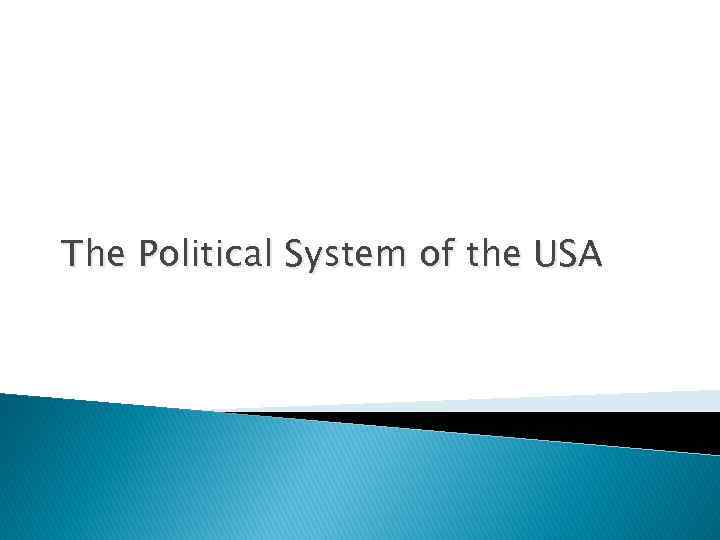 The Political System of the USA
The Political System of the USA
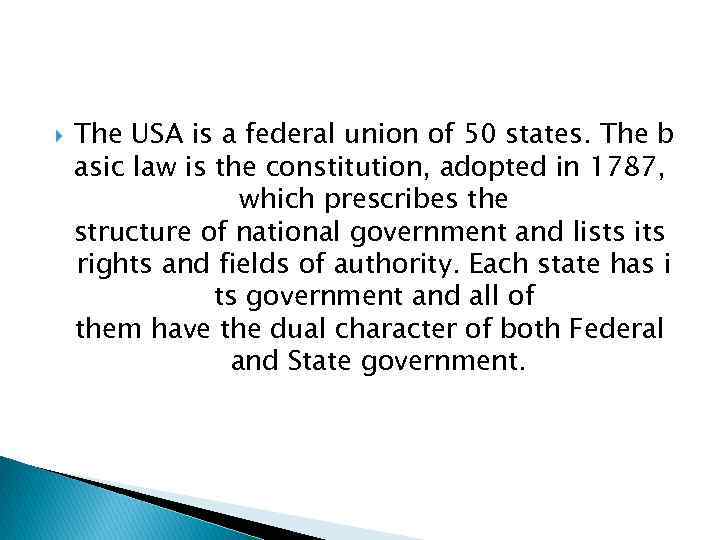 The USA is a federal union of 50 states. The b asic law is the constitution, adopted in 1787, which prescribes the structure of national government and lists its rights and fields of authority. Each state has i ts government and all of them have the dual character of both Federal and State government.
The USA is a federal union of 50 states. The b asic law is the constitution, adopted in 1787, which prescribes the structure of national government and lists its rights and fields of authority. Each state has i ts government and all of them have the dual character of both Federal and State government.
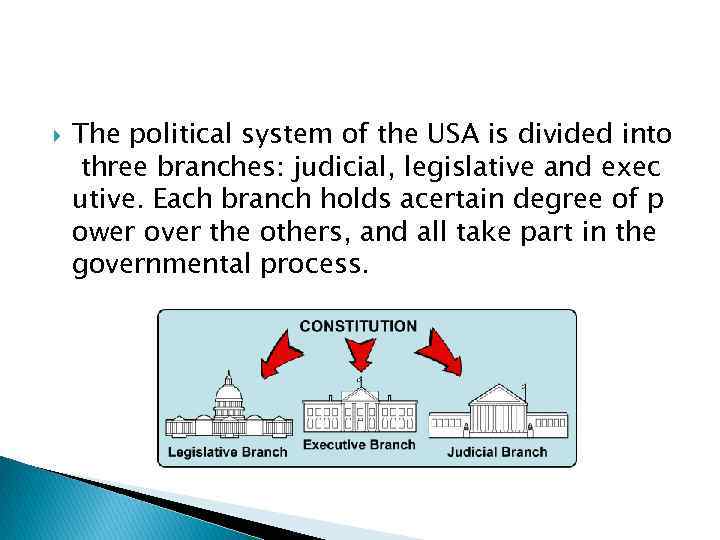 The political system of the USA is divided into three branches: judicial, legislative and exec utive. Each branch holds acertain degree of p ower over the others, and all take part in the governmental process.
The political system of the USA is divided into three branches: judicial, legislative and exec utive. Each branch holds acertain degree of p ower over the others, and all take part in the governmental process.
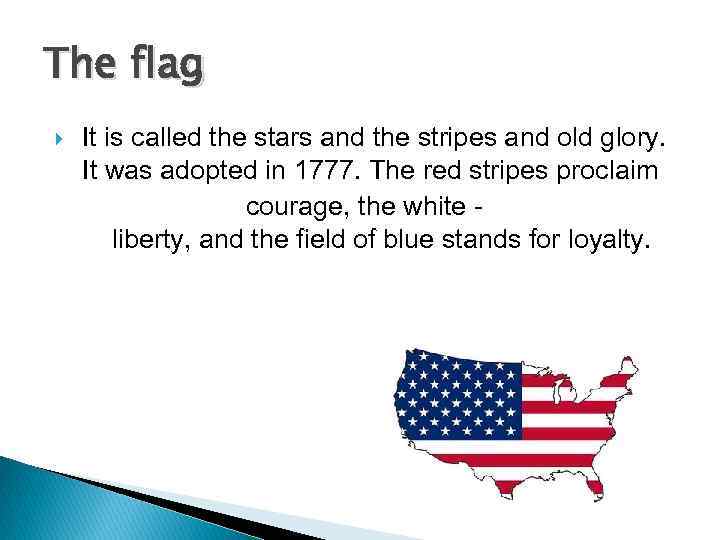 The flag It is called the stars and the stripes and old glory. It was adopted in 1777. The red stripes proclaim сourage, the white liberty, and the field of blue stands for loyalty.
The flag It is called the stars and the stripes and old glory. It was adopted in 1777. The red stripes proclaim сourage, the white liberty, and the field of blue stands for loyalty.
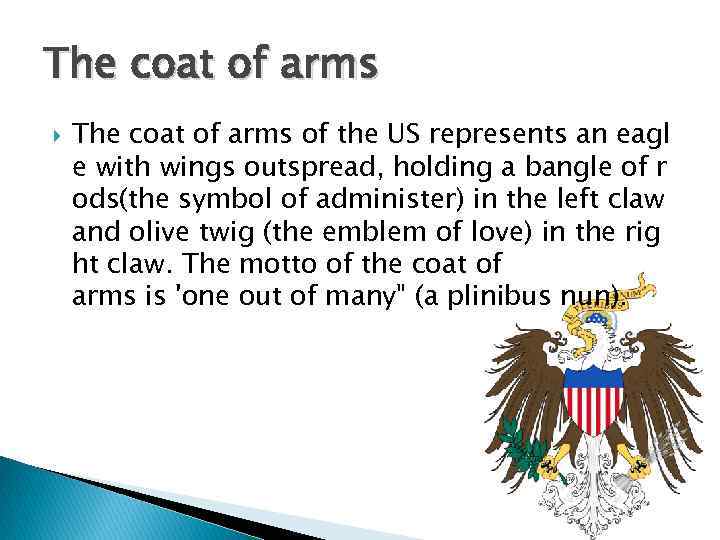 The coat of arms of the US represents an eagl e with wings outspread, holding a bangle of r ods(the symbol of administer) in the left claw and olive twig (the emblem of love) in the rig ht claw. The motto of the coat of arms is 'one out of many" (a plinibus nun).
The coat of arms of the US represents an eagl e with wings outspread, holding a bangle of r ods(the symbol of administer) in the left claw and olive twig (the emblem of love) in the rig ht claw. The motto of the coat of arms is 'one out of many" (a plinibus nun).
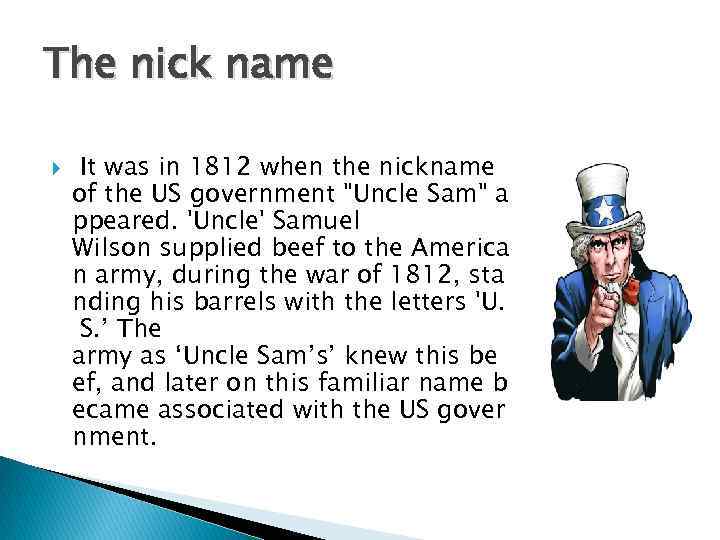 The nick name It was in 1812 when the nickname of the US government "Uncle Sam" a ppeared. 'Uncle' Samuel Wilson supplied beef to the America n army, during the war of 1812, sta nding his barrels with the letters 'U. S. ’ The army as ‘Uncle Sam’s’ knew this be ef, and later on this familiar name b ecame associated with the US gover nment.
The nick name It was in 1812 when the nickname of the US government "Uncle Sam" a ppeared. 'Uncle' Samuel Wilson supplied beef to the America n army, during the war of 1812, sta nding his barrels with the letters 'U. S. ’ The army as ‘Uncle Sam’s’ knew this be ef, and later on this familiar name b ecame associated with the US gover nment.
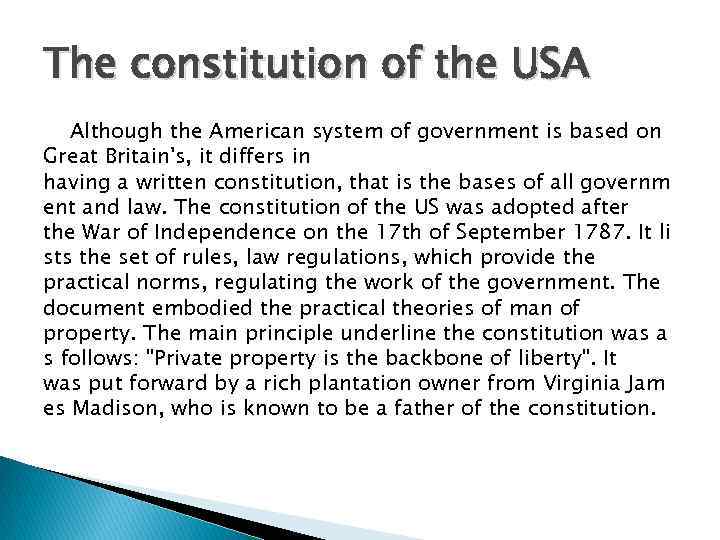 The constitution of the USA Although the American system of government is based on Great Britain's, it differs in having a written constitution, that is the bases of all governm ent and law. The constitution of the US was adopted after the War of Independence on the 17 th of September 1787. It li sts the set of rules, law regulations, which provide the practical norms, regulating the work of the government. The document embodied the practical theories of man of property. The main principle underline the constitution was a s follows: "Private property is the backbone of liberty". It was put forward by a rich plantation owner from Virginia Jam es Madison, who is known to be a father of the constitution.
The constitution of the USA Although the American system of government is based on Great Britain's, it differs in having a written constitution, that is the bases of all governm ent and law. The constitution of the US was adopted after the War of Independence on the 17 th of September 1787. It li sts the set of rules, law regulations, which provide the practical norms, regulating the work of the government. The document embodied the practical theories of man of property. The main principle underline the constitution was a s follows: "Private property is the backbone of liberty". It was put forward by a rich plantation owner from Virginia Jam es Madison, who is known to be a father of the constitution.
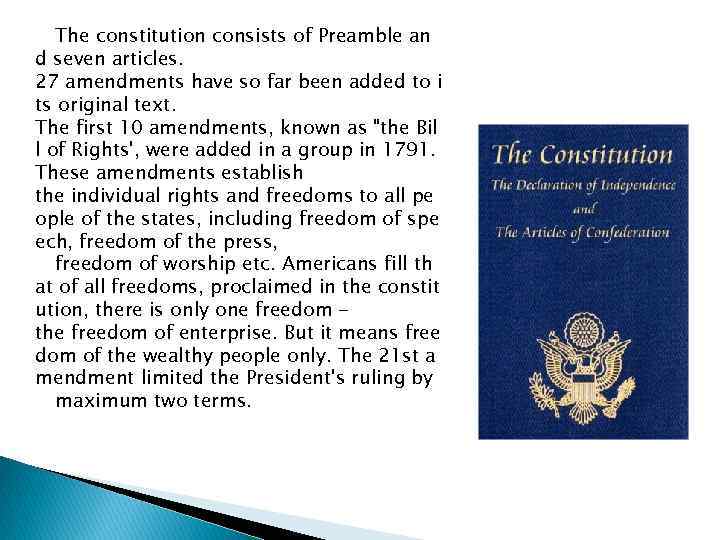 The constitution consists of Preamble an d seven articles. 27 amendments have so far been added to i ts original text. The first 10 amendments, known as "the Bil l of Rights', were added in a group in 1791. These amendments establish the individual rights and freedoms to all pe ople of the states, including freedom of spe ech, freedom of the press, freedom of worship etc. Americans fill th at of all freedoms, proclaimed in the constit ution, there is only one freedom the freedom of enterprise. But it means free dom of the wealthy people only. The 21 st a mendment limited the President's ruling by maximum two terms.
The constitution consists of Preamble an d seven articles. 27 amendments have so far been added to i ts original text. The first 10 amendments, known as "the Bil l of Rights', were added in a group in 1791. These amendments establish the individual rights and freedoms to all pe ople of the states, including freedom of spe ech, freedom of the press, freedom of worship etc. Americans fill th at of all freedoms, proclaimed in the constit ution, there is only one freedom the freedom of enterprise. But it means free dom of the wealthy people only. The 21 st a mendment limited the President's ruling by maximum two terms.
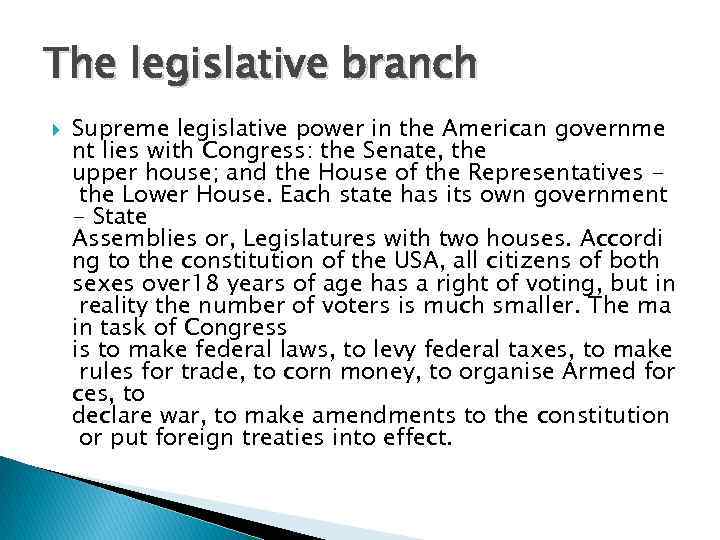 The legislative branch Supreme legislative power in the American governme nt lies with Congress: the Senate, the upper house; and the House of the Representatives the Lower House. Each state has its own government - State Assemblies or, Legislatures with two houses. Accordi ng to the constitution of the USA, all citizens of both sexes over 18 years of age has a right of voting, but in reality the number of voters is much smaller. The ma in task of Congress is to make federal laws, to levy federal taxes, to make rules for trade, to corn money, to organise Armed for ces, to declare war, to make amendments to the constitution or put foreign treaties into effect.
The legislative branch Supreme legislative power in the American governme nt lies with Congress: the Senate, the upper house; and the House of the Representatives the Lower House. Each state has its own government - State Assemblies or, Legislatures with two houses. Accordi ng to the constitution of the USA, all citizens of both sexes over 18 years of age has a right of voting, but in reality the number of voters is much smaller. The ma in task of Congress is to make federal laws, to levy federal taxes, to make rules for trade, to corn money, to organise Armed for ces, to declare war, to make amendments to the constitution or put foreign treaties into effect.
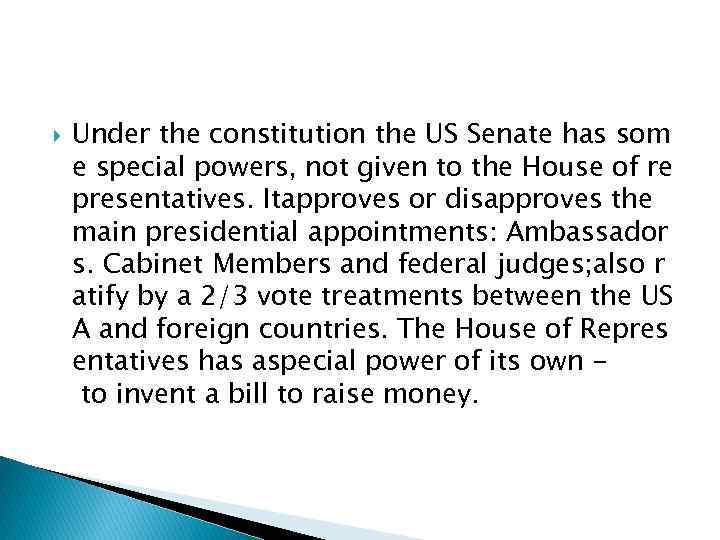 Under the constitution the US Senate has som e special powers, not given to the House of re presentatives. Itapproves or disapproves the main presidential appointments: Ambassador s. Cabinet Members and federal judges; also r atify by a 2/3 vote treatments between the US A and foreign countries. The House of Repres entatives has aspecial power of its own to invent a bill to raise money.
Under the constitution the US Senate has som e special powers, not given to the House of re presentatives. Itapproves or disapproves the main presidential appointments: Ambassador s. Cabinet Members and federal judges; also r atify by a 2/3 vote treatments between the US A and foreign countries. The House of Repres entatives has aspecial power of its own to invent a bill to raise money.
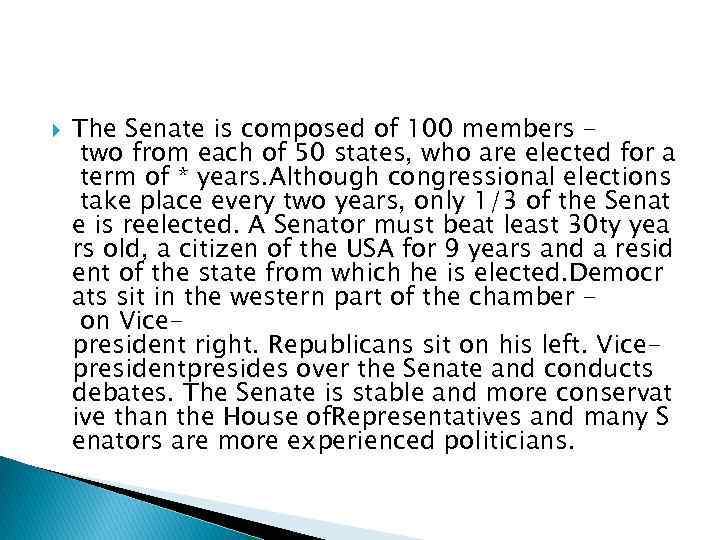 The Senate is composed of 100 members two from each of 50 states, who are elected for a term of * years. Although congressional elections take place every two years, only 1/3 of the Senat e is reelected. A Senator must beat least 30 ty yea rs old, a citizen of the USA for 9 years and a resid ent of the state from which he is elected. Democr ats sit in the western part of the chamber on Vicepresident right. Republicans sit on his left. Vicepresidentpresides over the Senate and conducts debates. The Senate is stable and more conservat ive than the House of. Representatives and many S enators are more experienced politicians.
The Senate is composed of 100 members two from each of 50 states, who are elected for a term of * years. Although congressional elections take place every two years, only 1/3 of the Senat e is reelected. A Senator must beat least 30 ty yea rs old, a citizen of the USA for 9 years and a resid ent of the state from which he is elected. Democr ats sit in the western part of the chamber on Vicepresident right. Republicans sit on his left. Vicepresidentpresides over the Senate and conducts debates. The Senate is stable and more conservat ive than the House of. Representatives and many S enators are more experienced politicians.
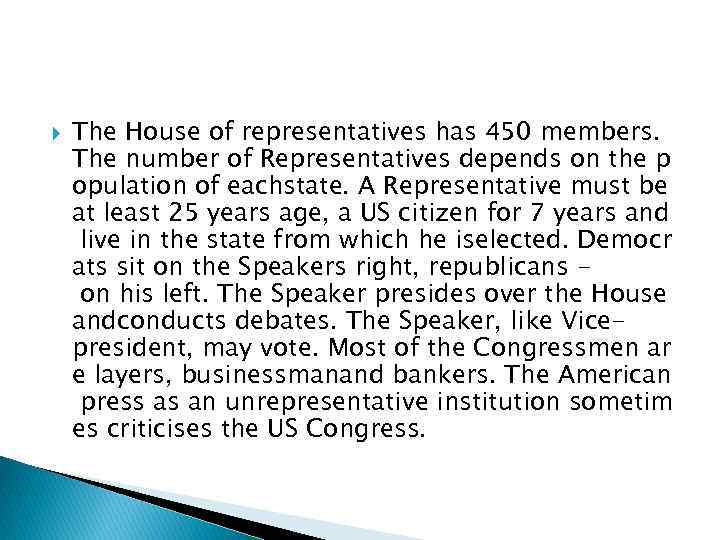 The House of representatives has 450 members. The number of Representatives depends on the p opulation of eachstate. A Representative must be at least 25 years age, a US citizen for 7 years and live in the state from which he iselected. Democr ats sit on the Speakers right, republicans on his left. The Speaker presides over the House andconducts debates. The Speaker, like Vicepresident, may vote. Most of the Congressmen ar e layers, businessmanand bankers. The American press as an unrepresentative institution sometim es criticises the US Congress.
The House of representatives has 450 members. The number of Representatives depends on the p opulation of eachstate. A Representative must be at least 25 years age, a US citizen for 7 years and live in the state from which he iselected. Democr ats sit on the Speakers right, republicans on his left. The Speaker presides over the House andconducts debates. The Speaker, like Vicepresident, may vote. Most of the Congressmen ar e layers, businessmanand bankers. The American press as an unrepresentative institution sometim es criticises the US Congress.
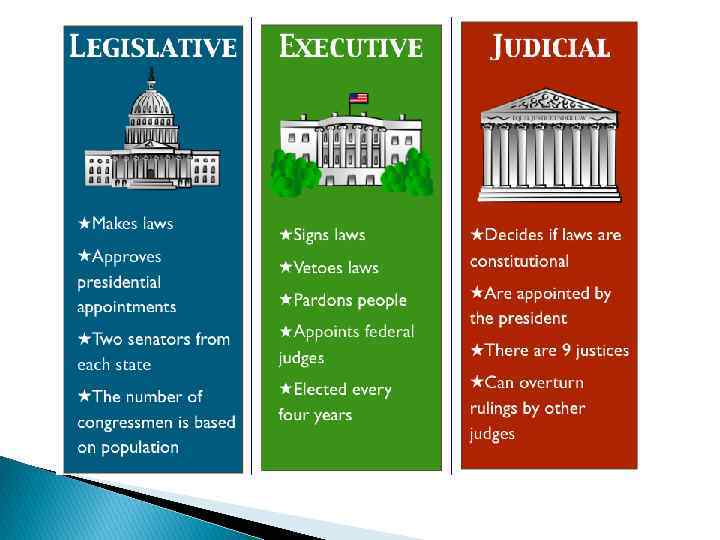
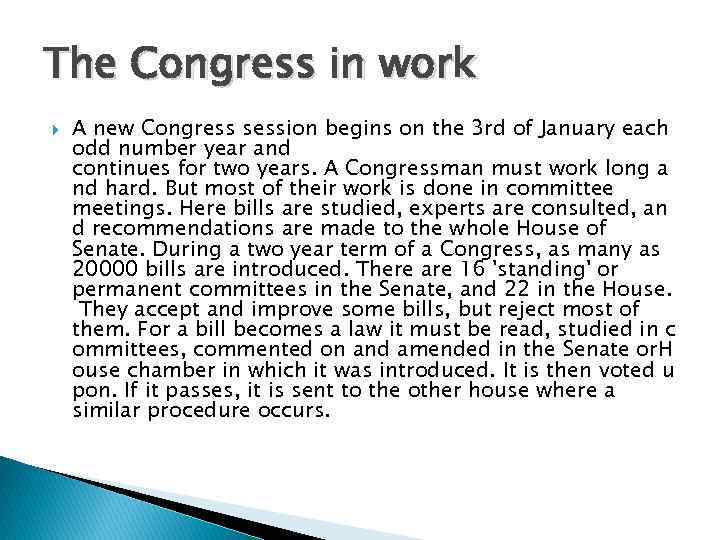 The Congress in work A new Congress session begins on the 3 rd of January each odd number year and continues for two years. A Congressman must work long a nd hard. But most of their work is done in committee meetings. Here bills are studied, experts are consulted, an d recommendations are made to the whole House of Senate. During a two year term of a Congress, as many as 20000 bills are introduced. There are 16 'standing' or permanent committees in the Senate, and 22 in the House. They accept and improve some bills, but reject most of them. For a bill becomes a law it must be read, studied in c ommittees, commented on and amended in the Senate or. H ouse chamber in which it was introduced. It is then voted u pon. If it passes, it is sent to the other house where a similar procedure occurs.
The Congress in work A new Congress session begins on the 3 rd of January each odd number year and continues for two years. A Congressman must work long a nd hard. But most of their work is done in committee meetings. Here bills are studied, experts are consulted, an d recommendations are made to the whole House of Senate. During a two year term of a Congress, as many as 20000 bills are introduced. There are 16 'standing' or permanent committees in the Senate, and 22 in the House. They accept and improve some bills, but reject most of them. For a bill becomes a law it must be read, studied in c ommittees, commented on and amended in the Senate or. H ouse chamber in which it was introduced. It is then voted u pon. If it passes, it is sent to the other house where a similar procedure occurs.
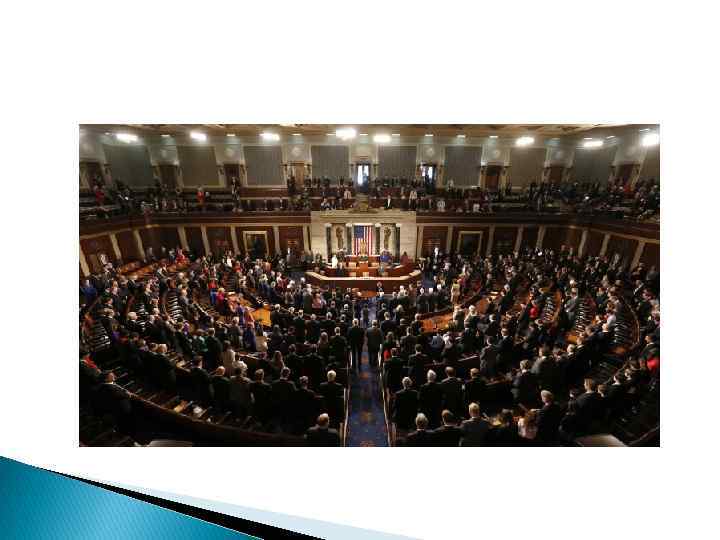
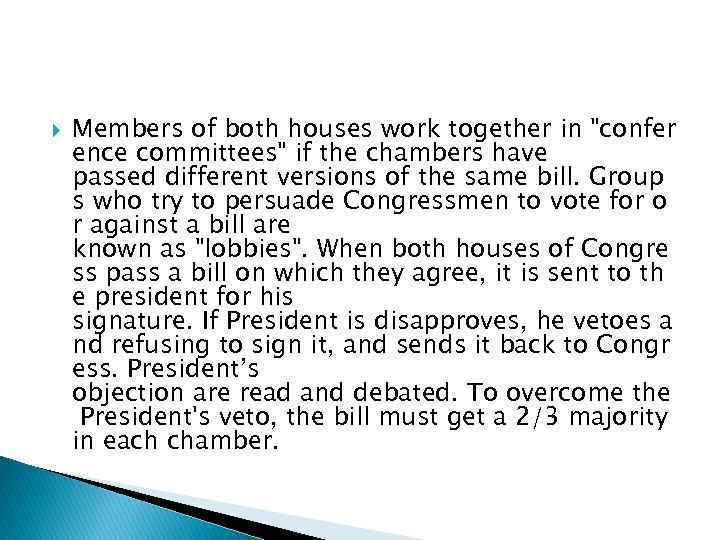 Members of both houses work together in "confer ence committees" if the chambers have passed different versions of the same bill. Group s who try to persuade Congressmen to vote for o r against a bill are known as "lobbies". When both houses of Congre ss pass a bill on which they agree, it is sent to th e president for his signature. If President is disapproves, he vetoes a nd refusing to sign it, and sends it back to Congr ess. President’s objection are read and debated. To overcome the President's veto, the bill must get a 2/3 majority in each chamber.
Members of both houses work together in "confer ence committees" if the chambers have passed different versions of the same bill. Group s who try to persuade Congressmen to vote for o r against a bill are known as "lobbies". When both houses of Congre ss pass a bill on which they agree, it is sent to th e president for his signature. If President is disapproves, he vetoes a nd refusing to sign it, and sends it back to Congr ess. President’s objection are read and debated. To overcome the President's veto, the bill must get a 2/3 majority in each chamber.
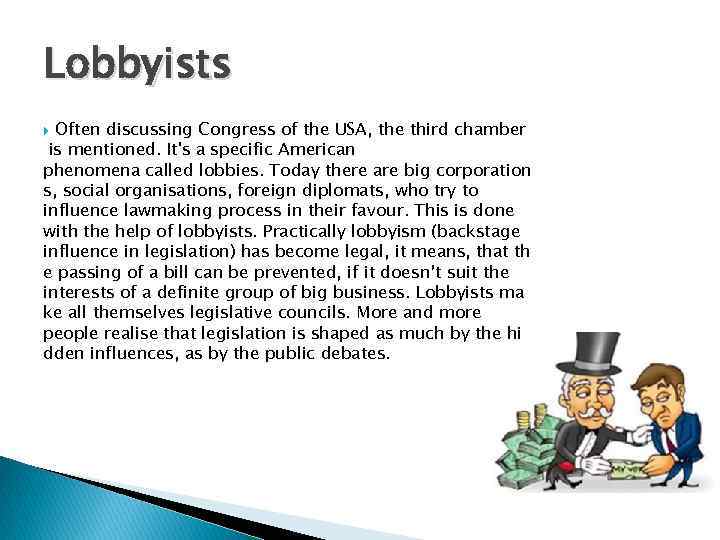 Lobbyists Often discussing Congress of the USA, the third chamber is mentioned. It's a specific American phenomena called lobbies. Today there are big corporation s, social organisations, foreign diplomats, who try to influence lawmaking process in their favour. This is done with the help of lobbyists. Practically lobbyism (backstage influence in legislation) has become legal, it means, that th e passing of a bill can be prevented, if it doesn’t suit the interests of a definite group of big business. Lobbyists ma ke all themselves legislative councils. More and more people realise that legislation is shaped as much by the hi dden influences, as by the public debates.
Lobbyists Often discussing Congress of the USA, the third chamber is mentioned. It's a specific American phenomena called lobbies. Today there are big corporation s, social organisations, foreign diplomats, who try to influence lawmaking process in their favour. This is done with the help of lobbyists. Practically lobbyism (backstage influence in legislation) has become legal, it means, that th e passing of a bill can be prevented, if it doesn’t suit the interests of a definite group of big business. Lobbyists ma ke all themselves legislative councils. More and more people realise that legislation is shaped as much by the hi dden influences, as by the public debates.
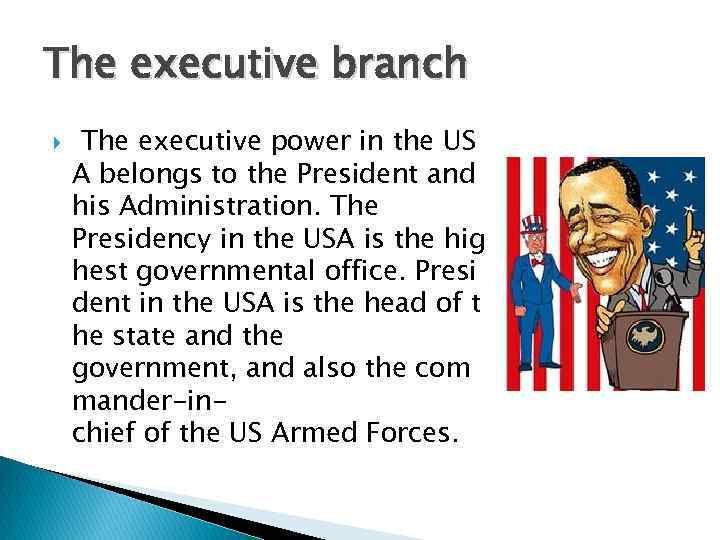 The executive branch The executive power in the US A belongs to the President and his Administration. The Presidency in the USA is the hig hest governmental office. Presi dent in the USA is the head of t he state and the government, and also the com mander-inchief of the US Armed Forces.
The executive branch The executive power in the US A belongs to the President and his Administration. The Presidency in the USA is the hig hest governmental office. Presi dent in the USA is the head of t he state and the government, and also the com mander-inchief of the US Armed Forces.
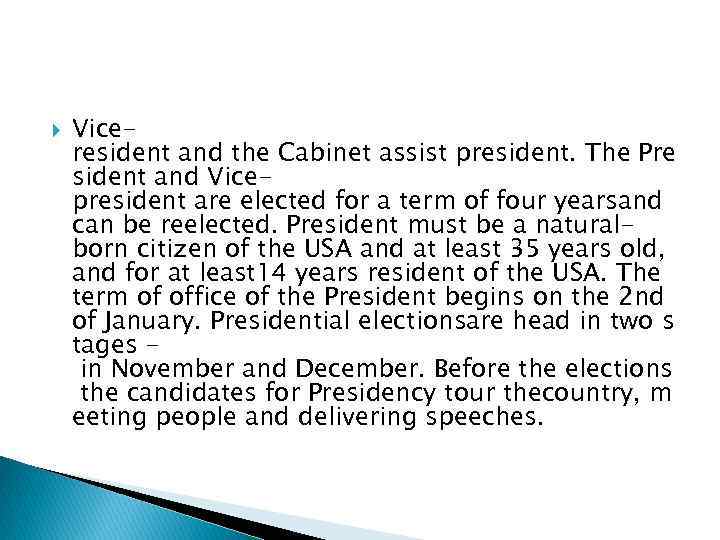 Viceresident and the Cabinet assist president. The Pre sident and Vicepresident are elected for a term of four yearsand can be reelected. President must be a naturalborn citizen of the USA and at least 35 years old, and for at least 14 years resident of the USA. The term of office of the President begins on the 2 nd of January. Presidential electionsare head in two s tages in November and December. Before the elections the candidates for Presidency tour thecountry, m eeting people and delivering speeches.
Viceresident and the Cabinet assist president. The Pre sident and Vicepresident are elected for a term of four yearsand can be reelected. President must be a naturalborn citizen of the USA and at least 35 years old, and for at least 14 years resident of the USA. The term of office of the President begins on the 2 nd of January. Presidential electionsare head in two s tages in November and December. Before the elections the candidates for Presidency tour thecountry, m eeting people and delivering speeches.
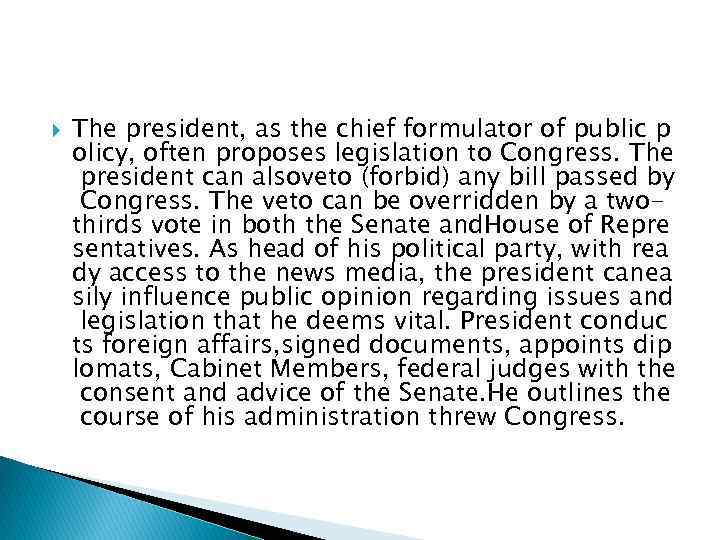 The president, as the chief formulator of public p olicy, often proposes legislation to Congress. The president can alsoveto (forbid) any bill passed by Congress. The veto can be overridden by a twothirds vote in both the Senate and. House of Repre sentatives. As head of his political party, with rea dy access to the news media, the president canea sily influence public opinion regarding issues and legislation that he deems vital. President conduc ts foreign affairs, signed documents, appoints dip lomats, Cabinet Members, federal judges with the consent and advice of the Senate. He outlines the course of his administration threw Congress.
The president, as the chief formulator of public p olicy, often proposes legislation to Congress. The president can alsoveto (forbid) any bill passed by Congress. The veto can be overridden by a twothirds vote in both the Senate and. House of Repre sentatives. As head of his political party, with rea dy access to the news media, the president canea sily influence public opinion regarding issues and legislation that he deems vital. President conduc ts foreign affairs, signed documents, appoints dip lomats, Cabinet Members, federal judges with the consent and advice of the Senate. He outlines the course of his administration threw Congress.
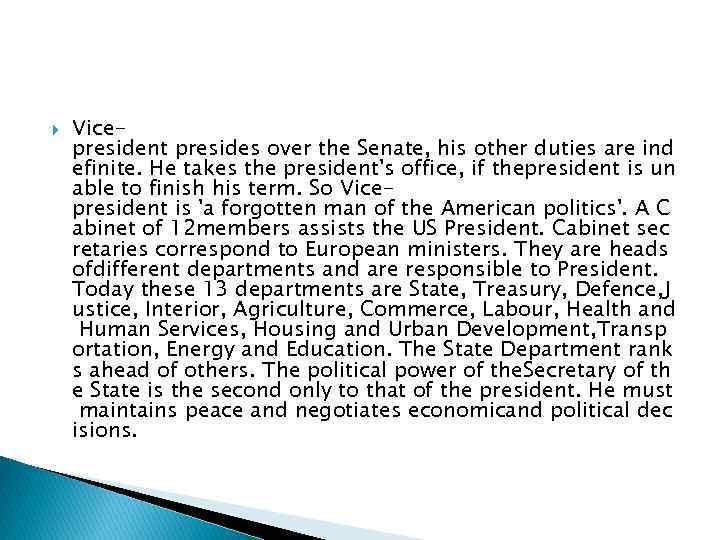 Vicepresident presides over the Senate, his other duties are ind efinite. He takes the president's office, if thepresident is un able to finish his term. So Vicepresident is 'a forgotten man of the American politics'. A C abinet of 12 members assists the US President. Cabinet sec retaries correspond to European ministers. They are heads ofdifferent departments and are responsible to President. Today these 13 departments are State, Treasury, Defence, J ustice, Interior, Agriculture, Commerce, Labour, Health and Human Services, Housing and Urban Development, Transp ortation, Energy and Education. The State Department rank s ahead of others. The political power of the. Secretary of th e State is the second only to that of the president. He must maintains peace and negotiates economicand political dec isions.
Vicepresident presides over the Senate, his other duties are ind efinite. He takes the president's office, if thepresident is un able to finish his term. So Vicepresident is 'a forgotten man of the American politics'. A C abinet of 12 members assists the US President. Cabinet sec retaries correspond to European ministers. They are heads ofdifferent departments and are responsible to President. Today these 13 departments are State, Treasury, Defence, J ustice, Interior, Agriculture, Commerce, Labour, Health and Human Services, Housing and Urban Development, Transp ortation, Energy and Education. The State Department rank s ahead of others. The political power of the. Secretary of th e State is the second only to that of the president. He must maintains peace and negotiates economicand political dec isions.
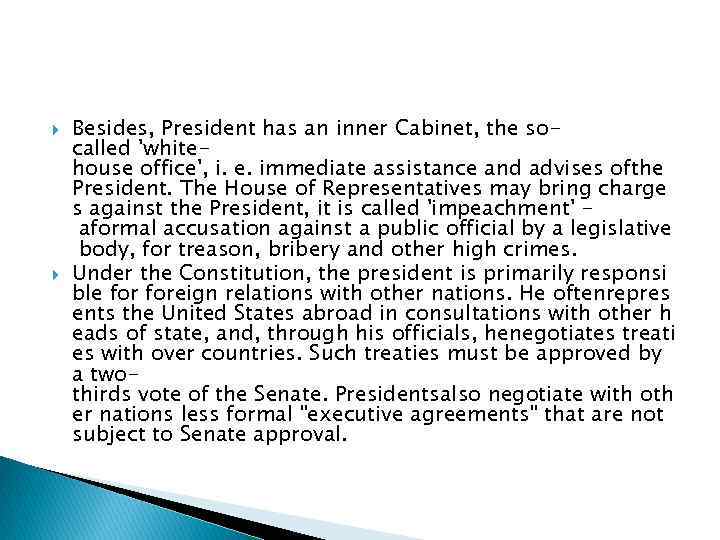 Besides, President has an inner Cabinet, the socalled 'whitehouse office', i. e. immediate assistance and advises ofthe President. The House of Representatives may bring charge s against the President, it is called 'impeachment' aformal accusation against a public official by a legislative body, for treason, bribery and other high crimes. Under the Constitution, the president is primarily responsi ble foreign relations with other nations. He oftenrepres ents the United States abroad in consultations with other h eads of state, and, through his officials, henegotiates treati es with over countries. Such treaties must be approved by a twothirds vote of the Senate. Presidentsalso negotiate with oth er nations less formal "executive agreements" that are not subject to Senate approval.
Besides, President has an inner Cabinet, the socalled 'whitehouse office', i. e. immediate assistance and advises ofthe President. The House of Representatives may bring charge s against the President, it is called 'impeachment' aformal accusation against a public official by a legislative body, for treason, bribery and other high crimes. Under the Constitution, the president is primarily responsi ble foreign relations with other nations. He oftenrepres ents the United States abroad in consultations with other h eads of state, and, through his officials, henegotiates treati es with over countries. Such treaties must be approved by a twothirds vote of the Senate. Presidentsalso negotiate with oth er nations less formal "executive agreements" that are not subject to Senate approval.
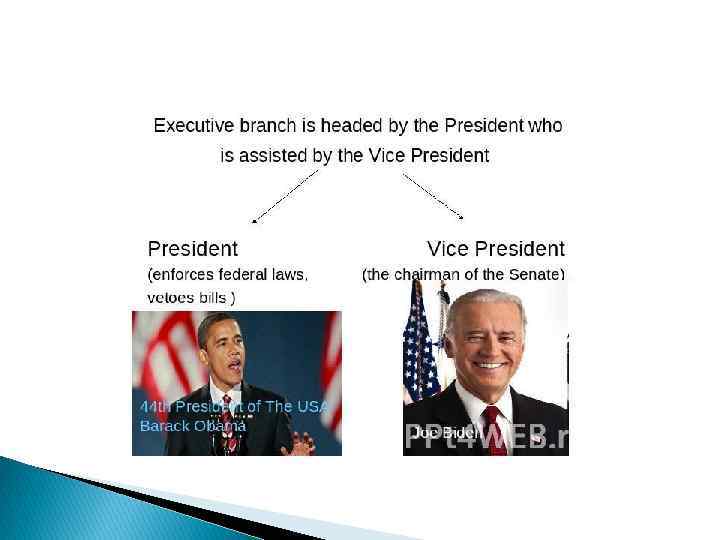
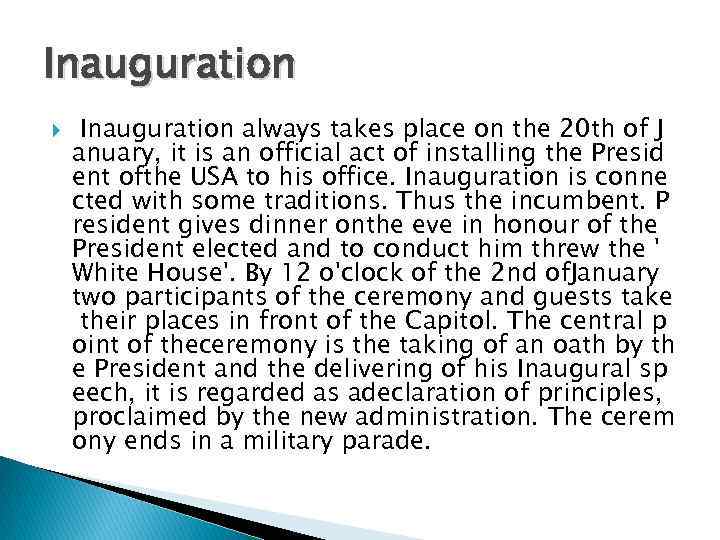 Inauguration always takes place on the 20 th of J anuary, it is an official act of installing the Presid ent ofthe USA to his office. Inauguration is conne cted with some traditions. Thus the incumbent. P resident gives dinner onthe eve in honour of the President elected and to conduct him threw the ' White House'. By 12 o'clock of the 2 nd of. January two participants of the ceremony and guests take their places in front of the Capitol. The central p oint of theceremony is the taking of an oath by th e President and the delivering of his Inaugural sp eech, it is regarded as adeclaration of principles, proclaimed by the new administration. The cerem ony ends in a military parade.
Inauguration always takes place on the 20 th of J anuary, it is an official act of installing the Presid ent ofthe USA to his office. Inauguration is conne cted with some traditions. Thus the incumbent. P resident gives dinner onthe eve in honour of the President elected and to conduct him threw the ' White House'. By 12 o'clock of the 2 nd of. January two participants of the ceremony and guests take their places in front of the Capitol. The central p oint of theceremony is the taking of an oath by th e President and the delivering of his Inaugural sp eech, it is regarded as adeclaration of principles, proclaimed by the new administration. The cerem ony ends in a military parade.
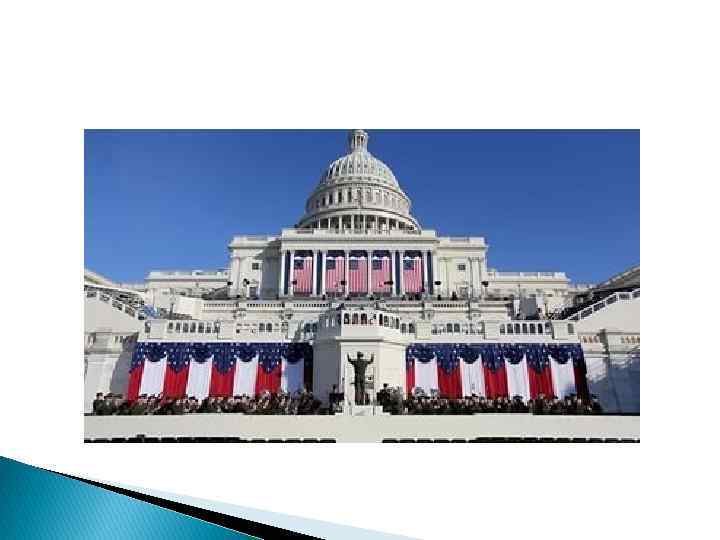
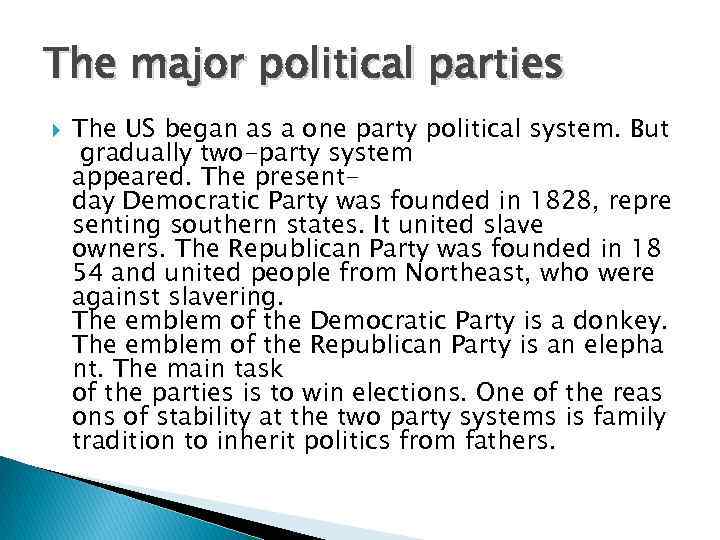 The major political parties The US began as a one party political system. But gradually two-party system appeared. The presentday Democratic Party was founded in 1828, repre senting southern states. It united slave owners. The Republican Party was founded in 18 54 and united people from Northeast, who were against slavering. The emblem of the Democratic Party is a donkey. The emblem of the Republican Party is an elepha nt. The main task of the parties is to win elections. One of the reas ons of stability at the two party systems is family tradition to inherit politics from fathers.
The major political parties The US began as a one party political system. But gradually two-party system appeared. The presentday Democratic Party was founded in 1828, repre senting southern states. It united slave owners. The Republican Party was founded in 18 54 and united people from Northeast, who were against slavering. The emblem of the Democratic Party is a donkey. The emblem of the Republican Party is an elepha nt. The main task of the parties is to win elections. One of the reas ons of stability at the two party systems is family tradition to inherit politics from fathers.
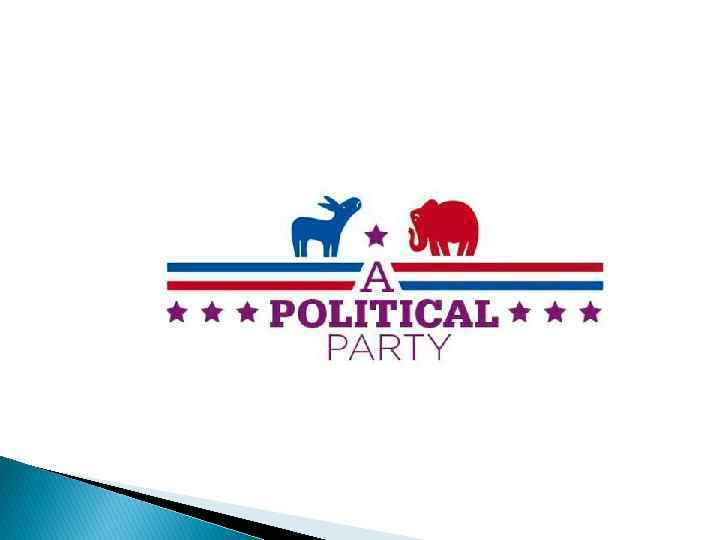
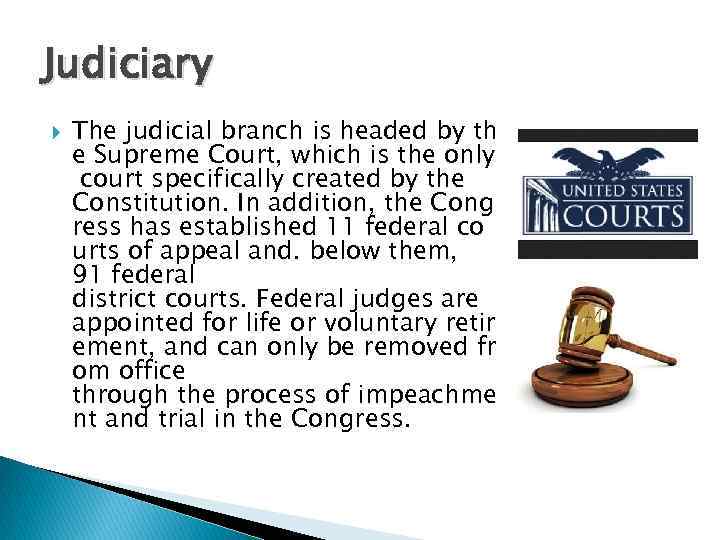 Judiciary The judicial branch is headed by th e Supreme Court, which is the only court specifically created by the Constitution. In addition, the Cong ress has established 11 federal co urts of appeal and. below them, 91 federal district courts. Federal judges are appointed for life or voluntary retir ement, and can only be removed fr om office through the process of impeachme nt and trial in the Congress.
Judiciary The judicial branch is headed by th e Supreme Court, which is the only court specifically created by the Constitution. In addition, the Cong ress has established 11 federal co urts of appeal and. below them, 91 federal district courts. Federal judges are appointed for life or voluntary retir ement, and can only be removed fr om office through the process of impeachme nt and trial in the Congress.
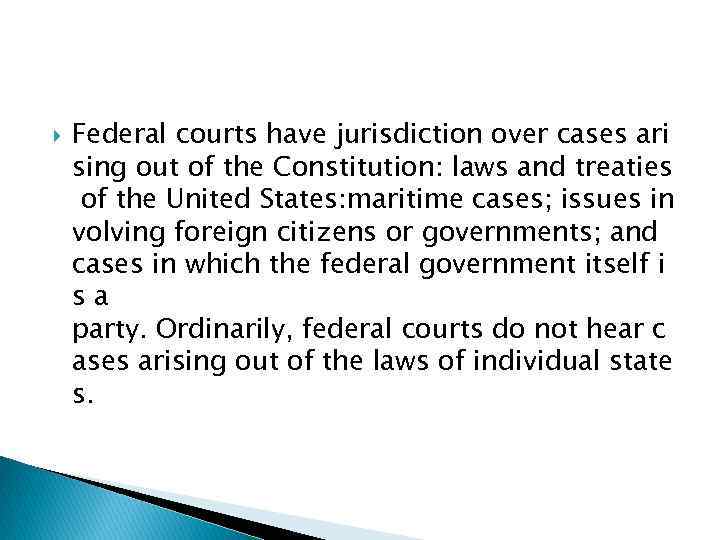 Federal courts have jurisdiction over cases ari sing out of the Constitution: laws and treaties of the United States: maritime cases; issues in volving foreign citizens or governments; and cases in which the federal government itself i s a party. Ordinarily, federal courts do not hear c ases arising out of the laws of individual state s.
Federal courts have jurisdiction over cases ari sing out of the Constitution: laws and treaties of the United States: maritime cases; issues in volving foreign citizens or governments; and cases in which the federal government itself i s a party. Ordinarily, federal courts do not hear c ases arising out of the laws of individual state s.
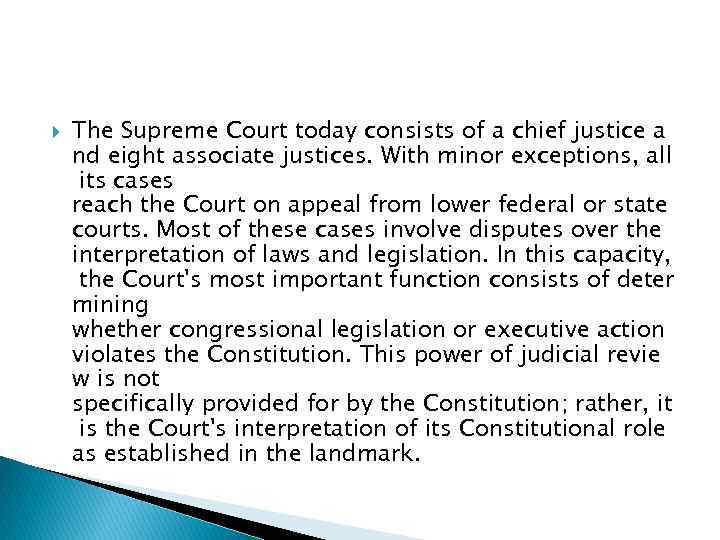 The Supreme Court today consists of a chief justice a nd eight associate justices. With minor exceptions, all its cases reach the Court on appeal from lower federal or state courts. Most of these cases involve disputes over the interpretation of laws and legislation. In this capacity, the Court's most important function consists of deter mining whether congressional legislation or executive action violates the Constitution. This power of judicial revie w is not specifically provided for by the Constitution; rather, it is the Court's interpretation of its Constitutional role as established in the landmark.
The Supreme Court today consists of a chief justice a nd eight associate justices. With minor exceptions, all its cases reach the Court on appeal from lower federal or state courts. Most of these cases involve disputes over the interpretation of laws and legislation. In this capacity, the Court's most important function consists of deter mining whether congressional legislation or executive action violates the Constitution. This power of judicial revie w is not specifically provided for by the Constitution; rather, it is the Court's interpretation of its Constitutional role as established in the landmark.
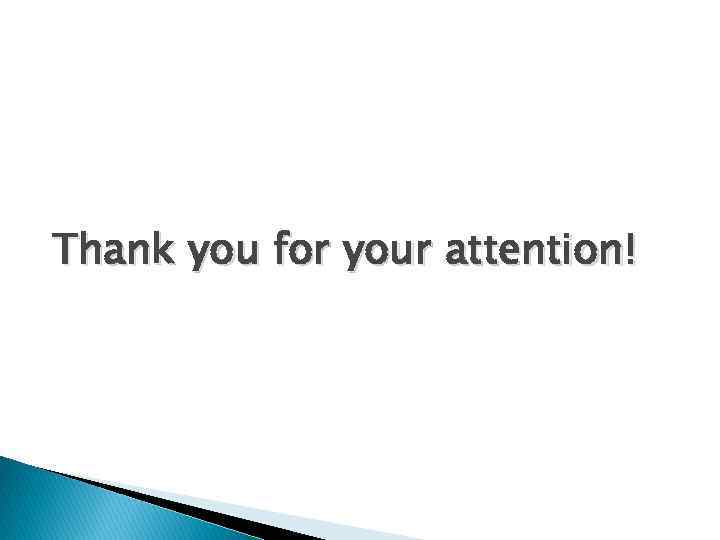 Thank you for your attention!
Thank you for your attention!
